| Dec-31-03 | | capanegra: I think the positional style deveolped by Mieses in this game is stunnig, specially the movements of the queen in order to catch the diagonal b8-h2. But I would like someone to answer one question. In an old book I have read, it says that after 31.Qh1!!, if black played 31...f5 instead of 31...Kd8, then 32.Qh2+ f4 33.Rxf4 Qxd1+ 34.Kb2 "and white wins". My question is: How could white win if black played 34...Kd8, getting off the discovered check, and with a rook ahead? Hence, this analysis would be wrong, and Mason made a mistake playing 31...Kd8 instead of 31...f5. |
|
| Dec-31-03 | | fatbaldguy: <capanegra> I think 34 ... Kd8 in your line does not save black, since 35 Rf7 will enable white to mate (with 36 Qb8, or with Qc7 if the black bishop moves). |
|
| Dec-31-03 | | capanegra: I see your point, but black still could evade mate with 35...Qxd4+ 36.Kb3 and would be forced to give the rook back through 36...Re3+ 37.f2xe3 Qxe3+ 38.c3 Ke8 39.Rf3 Qe1 40.Bd3 with a winning position for white. Do you agree? |
|
| Dec-31-03 | | fatbaldguy: Good point, black lives on for a while, at any rate it's better than what he played in the game. |
|
Oct-25-19
 | | KEG: A very exciting and complicated game. As usual, Mieses went on the attack. The extent to which his plan was sound is hard to assess. Not only the commentators but even Fritz and Stockfish often seem bewildered. I have struggled with this game almost as much as I have enjoyed playing it over. The extent some of Mieses' play was theoretically flawed only adds to the pleasure of trying to unravel what was going on. 1. e4 e6
2. d4 d5
3. exd5
The Exchange Variation of the French, a Mieses favorite. It has often been deemed drawish if not lifeless. Mieses, however, played this with every thought of attack and victory. 3... exd5
4. Be3
4. Nf3 and 4. Bd3 are most usual and perhaps theoretically best. The text, however, was Mieses' preferred line which he played at least 18 times. He had played it just two rounds earlier at Monte Carlo 1901 in his drawn game with Alapin. 4... Nf6
Probably better than Alapin's 4...Be6. The only problem with the text is that this was a variation Mieses knew well. Mason went down this same road in his game the following year against Mieses at Hanover 1902. Mieses won that game as well as the present encounter. 5. Bd3
Mieses played this so many times it should perhaps be called the "Mieses Variation." Alekhine played the same move in 1908, but we can safely attribute the move and its niceties to Mieses. 5... Bd6
6. Nc3

click for larger viewThis position may not look particularly dynamic, but Mieses knew it well. He played this line at least 11 times between 1889 and 1906. 6. Ne2 (preparing f4) is an interesting alternative. 6... c6
6...0-0 is a good alternative, and perhaps a way to get away from Mieses' preparation. 7. Qd2
A Mieses favorite. He played this move at least seven times, including his 1902 game against Mason. 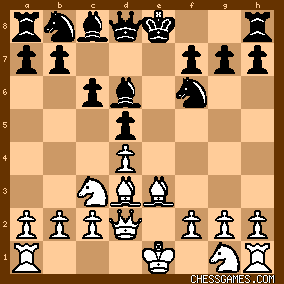
click for larger viewMieses loved these sorts of positions: castle long and attack on the other wing. Worse still for Black, he knew this very position very well. Whatever its theoretical merits, playing the Black side of this opening against Mieses was risky. 7... Qe7
"?"--(Tournament Book)
"An unhappy square for the Queen. It becomes pinned afterwards, and he has difficulties." (Tournament Book) A novelty, and not a good one. Mason played 7...Qa5 in his game against Mieses at Hanover 1902. That contest also did not go well for Mason. Best for Black here is probably the simple 7...0-0 after which Black is theoretically at least equal. 7...Na6 is also a possibility. After the text, Black's difficulties mount. 8. 0-0-0
All according to plan. 8. Nge2 also looks promising, but Mieses--as will be clear from what follows--wanted to keep his options open about where to post his g1 Knight. 8... Na6
Black's position already looks uncomfortable.
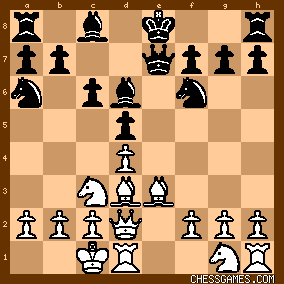
click for larger view9. Re1
The Fritz and Stockfish prefer 9. BxN or 9> Bf4. Bt Mieses wanted to keep his Bishops on the board (for a while--see move 15), and the suggested moves were no more in his DNA than they were in Janowski's (who also loved his Bishops). The problem with the text is that it allows 9...Nb4 giving Black good prospects. But no problem for Mieses, since Mason here erred with: 9... Be6
Now the doubtful positioning of Black's Queen became a problem for Mason (though, as will be seen, he still retained chances to play : 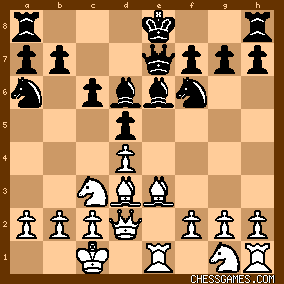
click for larger viewNote Mieses' Knight on g1. He still hadn't decided how to deploy this steed. |
|
Oct-26-19
 | | KEG: Post II
10. Bg5
10. f4 seems more in the spirit of Mieses' plan. Perhaps best play, however, was simply 10. a3 to eliminate Black's threat of Nb4. 10... h6
11. Bh4

click for larger view11... g5
Needlessly creating weaknesses for himself on the King-side. 11...0-0 was best. 11...Nb4 remained a possibility. 12. Bb3 Nc7
This can't be the best way to position the Knight. Why not 12...Nb4? After the text, the position wasa: 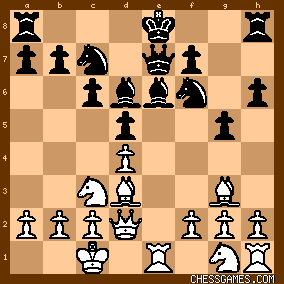
click for larger view13. Nf3
The Knight at last enters the game. But 13. f4 first seems much better. 13... Nd7
Mason was slowly ruining his position. 13...0-0-0, or 13...BxB and then 14...0-0-0, was indicated. 14. Ne5
Needlessly allowing Black to trade off minor pieces and relieve his congested game. Mieses had several better options here, e.g., 14. h4; 14. BxB; and perhaps 14. Nd1. 
click for larger view14... BxN
15. BxB NxB
16. RxN 0-0-0
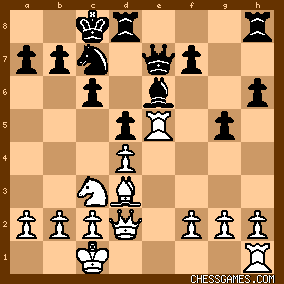
click for larger view17. Na4
The plan to get the Knight to c5 is easily thwarted. The Knight could be better posted beginning with 17. Ne2 or 17. Nd1. 17... b6
"The alternative would be to allow Nc5 but to dislodge the Rook first with 17...f6. The position becomes very delicate and complicated, therefore Black tried the more simple continuation." (Tournament Book). I don't see why 17...f6 18. Re3 would be any improvement for Black. In either case, the game would be in the balance and chances nearly equal. 18. h4
"!"--(Tournament Book)
"A good move." (Tournament Book).
Looks like an Alpha-Zero move. It is also consistent with Mieses' attack at all costs approach. A mortal might try 18. f4. Mieses' move--though theoretically questionable-- introduced the sort of complications he relished: 
click for larger view18... f6
18...gxh4 was surely best. The Tournament Book claimed that 18...gag4 would have been met by 19. f4. But: (A) 19. Rh5 would be better after 18...gxh4; and (B) in either case, Black looks better. After the text, chances were about even and Mieses' temerity went unpunished. 19. Re3
19. Ree1 seems simpler.
19... Qd6
19...Qg7 or 19. Qd7 were perhaps more accurate. After the text, the position was: 
click for larger view |
|
Oct-26-19
 | | KEG: Post III
20. b4?!
"Threatening Nc5, followed by Qa5 in case the Knight be taken, with an overwhelming attack." As always, Mieses plays for the attack heedless of the risks or of creating weaknesses in his own position. 20. Nc3, conceding the error of his 17th move, would have given him a slight advantage. Alternatively, he could have gotten his King to greater safety with 20. Kb1, or tried the prophylactic 20. a3. The text was the beginning of a plan that could easily have spelled disaster for Mieses. 20... Kb7
"!"--(Tournament Book)
"To liberate the Queen which he intends to move to f4." (Tournament Book). One bad plan deserves another. On the other hand, the text move was hardly a mistake, though he might have considered 20...Bd7 or 20...Rdg8 (going after the minimally defended White Queen-side if--like Mieses--he was prepared to run risks). 21. Qc3?!
While this all worked well for Mieses, blocking the c3 square makes little sense. He should have tried to consolidate (after his wild 20th move) 21. a3 or 21. Kb2. 21... Qf4
21...Bd7 or 21...Rde8 or 21...Rdg8 all seem better. The text move was easily parried. After the text, the position was:

click for larger viewBeginning here, Mieses went whole hog on his attacking scheme. This could have cost him the game had Mason exploited his chances. 22. Kb1?!
"!"--(Tournament Book)
"This and the following moves are the lead up to the later combination." (Tournament Book) Mieses could have punished Mason for his sloppy 21...Qf4 with 22. g3 (since 22...Qxf2 loses the Queen after 23. Re2! [since 23...Qxg3 runs into 24.Ba6!]). Now--contrary to the assessment by the Tournament Book--Mieses got into trouble and won (brilliantly I might add) only because of Mason's inaccurate play. 22... gxh4
"Of doubtful utility" (Tournament Book)
Actually, the text was best. Mason now threatens Qxf2 (among other things) since he could now safely retreat his Queen to g3 having his own pawn on h4. 
click for larger view23. Ka1?
"!"--(Tournament Book)
He might as well have played 23. Ba6+ at once. After the text, Mieses--the Tournament Book notwithstanding--was probably lost. 23... Bd7
Even more simply, Mason could just have gobbled up Mieses' f-pawn with 23...Qxf2 (e.g., 24. Re2 Qf4 and if then 25. Ba6+ NxB 26. RxB Rc8 and Black is two pawns up in a safe position. The text, however, was probably also sufficient to win. 24. Rb1
24. g3 might have been more prudent, but by this point it was too late for Mieses to look back. 
click for larger viewFrom here, as will be seen, Mason got lost amidst the upcoming tactical fireworks and quickly lost his advantage. This, of course, is understandable. Mieses was a brilliant attacking player, and White's forces pointing at the Black King certainly look dangerous on first blush. |
|
Oct-26-19
 | | KEG: Post IV
24... Ne6?
Giving steam to Mieses' attack while missing a chance to obtain a winning advantage. Mason had several ways to win from here. Simplest was probably 24...Qxf2, e.g., 25. Re7 Qg3 leaving Black two pawns up with everything covered. Now, Mieses had chances.
25. Ba6+?!
"!" (Tournament Book)
Better was 25. b5! and if 25...cxb5 26. Bxb5 with compensation for the sacrificed pawn. 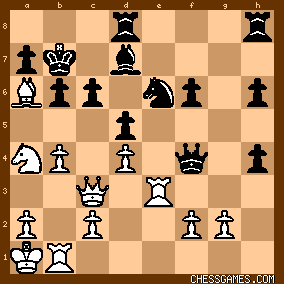
click for larger view25... Kc7?
As the Tournament Book pointed out, 25...KxB was much better and after 26. RxB Black would have fine winning chances after 26...Kb7 (but not--as the Tournament Book notes) 26...BxR? 27. Nc5+ (27. Qxc6 also wins--KEG) bxN 28. bxc5 and White, though down a Rook and a Bishop, has an easy win (Black can only avoid a quick mate by giving up his Queen with 27...Qd2). 26. Nc5!
"!"--(Tournament Book).
A remarkable position:
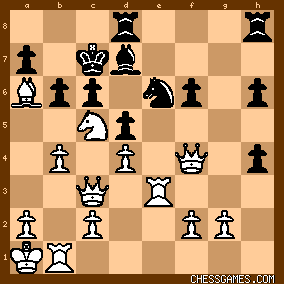
click for larger view26... NxN
As the Tournament Book pointed out, 26...bxN loses to 27. bxN (27...Bc8 28. RxN [if 28...BxR? 29. Rb7+ and mates in three]or 27...Rb8 28. Qa5+ 26...Nxd4 is also inferior to the text, but the Tournament Book's analysis of the ensuing play is flawed: 27. Bd3? [White has a small edge with 27. NxB KxN 28. Rd1 while the suggested 27. Bd3 should lose] 27...bxN? [giving White a lifeline, Black should simply consolidate with 27...Rde8 or 27...Rhe8 or 27...Kb8] 28. Qa3 "with a strong attack." [Nonsense. White would be OK here with 28. bxc5. But after 28. Qa3? Black's King simply escapes to a8, leaving him up a piece with a clear win]. The text was not bad, but probably best for Black--and the only chance to play for any kind of advantage--was 26...Rhe8. After 26...NxN, White was very much back in the game. 27. bxN Rb8
27...Qxf2 would have led to a pretty draw by perpetual check: 28. cxb6+ axb6 29. Rxb6!! KxR 30. Qc5+ and draws!. The text, however, was also fine, and the position was now: 
click for larger view28. Rf3 Qg5
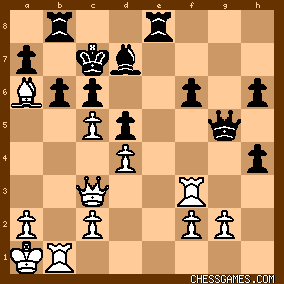
click for larger view29. Qe1
"!!"--(Tournament Book)
"A subtle and problem-like move, leading to a multitude of highly interesting variations, the immediate threat being 30. Qe7, and if 29...Rhe8 [?} 30.Qh1 [!!--an amazing winning move--KEG]." 29... Qg4
Once again, and as the Tournament Book again correctly noted, 29...Rhe8? would lose to 30. Qh1! Probably best for Black here was the courageous (in over-the-board play) 29...Qxg2 which could lead to the following pretty drawing line (which includes no less than three Rook sacrifices): 30. Qe7 QxR 31. Qd6+ Kd8 32. QxR+ Ke7 33. QxR Qc3+ and draws by perpetual check. After Mason's actual move, 29...Qg4, the position was: 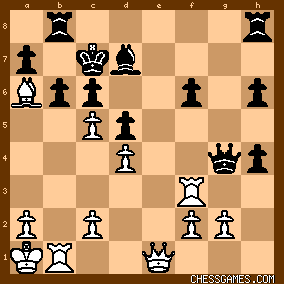
click for larger viewFrom here, things became truly fascinating as I will discuss in subsequent posts on this game. |
|
Oct-26-19
 | | KEG: Post V
30. Rd1
"Not to obstruct the diagonal of the Queen with 30. c3." (Tournament Book) 30. c3? would certainly be bad. The Tournament Book says it would be answered by 30...bxc5. While that would yield some advantage to Black (31. Rxf6 RxR+ 32. QxR Rb8+ 33. Qe1 Qg5), the game would be far from over and White would have good chances to survive. Instead, after 30. c3?, Black should play 30...Qxg2 with some chances to win after 31. Rxf6 Rbe8 32. Qd1 Qg5 33. Rf7 (33. Rd6 Rb8) Rhf8 34. Rh7 Re7 35. RxR QxR 36. Qa4 Bf5 (though the value of the Black doubled passed h-pawn is uncertain. Best for White would have been 30. Qb4, the fastest way to get the Queen to the Queenside. If then 30...Qxg2? 31. Ra3 with a likely win for White. After Mieses' 30. Rd1 the position was:
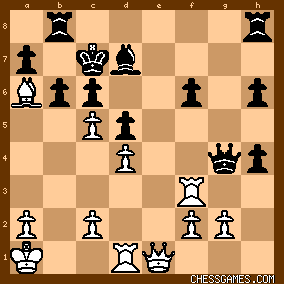
click for larger view30... Rbe8
Mason might have even been better with 30...Rhe8. The text, however, was sound and sufficient for equality. 31. Qh1
A very subtle move, the power of which apparently escaped Mason's notice. 31. Qb4 was also good, but the text is far more complex, and an amazing example of posting a Queen in the corner in a complex position, the position after 31. Qh1--one of the key positions in the game--was: 
click for larger view"A most difficult position..." (Tournament Book) True indeed!
31... Kd8?
This position was debated on this site years ago by <capanegra> and <fatbaldguy>. They continued the debate concerning the merits of 31...f5. Let's have a look at that move--which I believe is best (capanegra's initial conclusion). Everyone agrees that best play would then be 32. Qh2+ (the point of 31. Qh1) f4 (the point of 31...f5) 33. Rxf4! (a complex Rook sac rather than 33. Qxf4? QxQ 34. RxQ Ref8 and Black is much better) QxR+ 34. Kb2 leaving the position as follows: 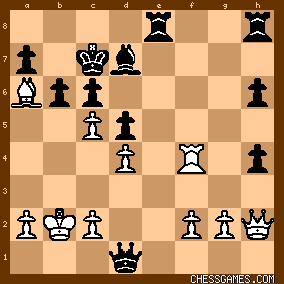
click for larger viewThe Tournament Book, capanegra, and fatbaldguy all considered 34...Kd8! here (which in fact saves the game for Black). fatbaldguy here claimed a win with 35. Rf7, but this loses to 35...Qxd4+ 36. Kb3 (36. c3 is slightly better but also loses) and now 36...Re5 or 36...Qe5 (blocking the h2...b8 diagonal) wins for Black. By contrast, 36...Re3+ makes Blacks win harder after 37. fxR Qxe3+ 38. c3, and now 38...Ke8?? (given as correct by capanegra and fatbaldguy) loses to 39. Rg7 (even better than capanegra's 39. Rf3). In the above-diagrammed position, Black can also save the game with the alternative move considered by the Tournament Book, 34...bxc5 (35. dxc5 Re5 36. Rb4 with equal chances. But back to the actual game: After Mason's 31...Kd8, the positionwas: 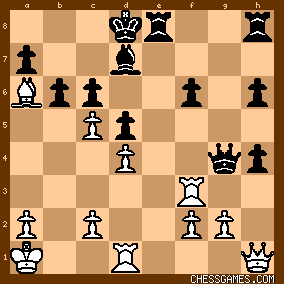
click for larger view32. Qh2!
This problem-like move makes Black work for the draw: 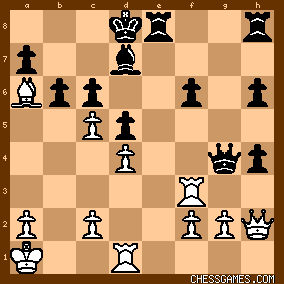
click for larger viewAlthough not pointed out by any commentator I have read, it was here that Mason made his fatal blunder after which he was blown off the board by Mieses. |
|
Oct-26-19
 | | KEG: Post VI
32... bxc5?
The losing move. Black, though worse, would still have been in the game after 33...Rhf8 or 33...Rhg8. After the text, Mieses finished nicely. 33. Qd6!
"!"--(Tournament Book)
"The only correct move [agreed--KEG], threatening mate with Rb1." (Tournament Book) 
click for larger view33... Qe6
33...Re6 might have held out a tad longer, but would have been to no avail. 34. Qxc5 Bc8
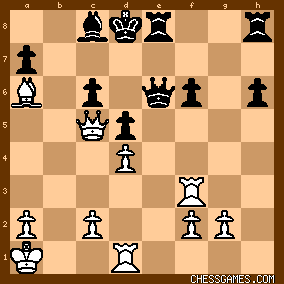
click for larger view35. BxB
"!"--(Tournament Book)
35... QxB
This was hopeless, but it hardly mattered anymore. If 35...KxB 36. Rb1. 36. Rxf6

click for larger view36... Re6
37. Rf7
37. RxR QxR 38. Rb1 would have been even more brutal. 37... Ke8
38. Qxa7
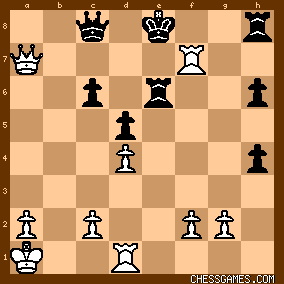
click for larger view38... Rf8
39. Rb7
1-0
Mate or loss of his Queen is inevitable. |
|
|
|
|





